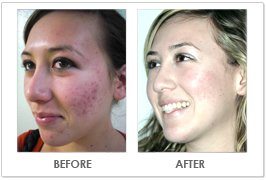To Schedule Appointments: 309-360-9035
Other Inquiries: 309-360-8077
If you have ever had acne, you know it can be frustrating to live with. It is difficult to get rid of and can affect self-esteem. Acne is the third most commonly treated skin disorder treated by Dermatologists and Estheticians. It affects up to 80% of adolescents and continues to affect 40-50% of adult women.
Acne is a hereditary condition that is most often a result of hormonal changes that causes the oil glands to secrete too much oil. The sebaceous oil and dead cells create a plug in the oil duct and bacteria begins to form. This causes the follicle to become swollen, inflamed and then filled with pus. Acne may be aggravated further by emotional stress, environmental factors, picking at the pimples and occasionally by diet.
Acne commonly occurs in adolescents because hormonal changes stimulate the sebaceous gland, however acne may continue long after adolescence. It may be aggravated later in life by general hormonal changes, oral contraceptives, lifestyle and stress.

People with acne are usually willing to try anything to get rid of it, and when something doesn’t work right away, they tend to switch to the next promising solution. In frustration, they try to dry it out with excessive washing, exfoliation, and harsh products. This usually causes more inflammation, irritates the skin and causes more problems. In my practice, I see many people with acne who can’t leave their skin alone. They pick and push, trying to get it to go away, and usually end up causing it to look worse. Pickers usually end up with not only worse acne, but often times long term scarring.

There are several grades of acne, and knowing the different types can be helpful in what treatment should be sought.
Grade 1 – mostly open and closed comedones (blackheads and whiteheads or milia) with an occasional pimple. This type of acne can usually be treated at home with salicylic and lactic acid based cleansers and moisturizers and a gentle exfoliation up to 3 times a week. A professional exfoliation once a month also helps keep dead skin off of the surface so that oils can get out.
Grade 2 – very large number of closed comedones (whiteheads) with occasional pustules (pimple with a head) or papules (a closed pimple with no visible head). In addition to salicylic and lactic acid based products, Benzoyl Peroxide may be introduced to kill the acne bacteria that causes pimples. Depending on how aggressive someone wants to get, either monthly treatments or weekly Dadashie treatments can get this acne under control.

Grade 3 – Large number of open and closed comedones and many papules and pustules. It is very inflamed and red. A person with this type of acne should be following the guidance of an Esthetician. Weekly Dadashie treatments are the best course of action, but a more organic approach could also be recommended.
Grade 4 – Commonly referred to as cystic acne, with many deep cysts and scar formation. Dadashie is still a great treatment for Grade 4 acne, but the client may be advised to seek the help of a Dermatologist for a stronger course of action so that further scarring can be prevented. Once the acne is under control, a Plastic Surgeon can address scarring.
When acne presents itself, it is best to seek someone who has experience dealing with it and let them guide you through the best products and treatments to prevent it from getting worse and scarring. There isn’t an easy overnight fix, but with patience and a no-picking policy, it doesn’t have to ruin your life.
Infuse offers many treatment options for acne
By: Mary Hayse, Licensed Esthetician